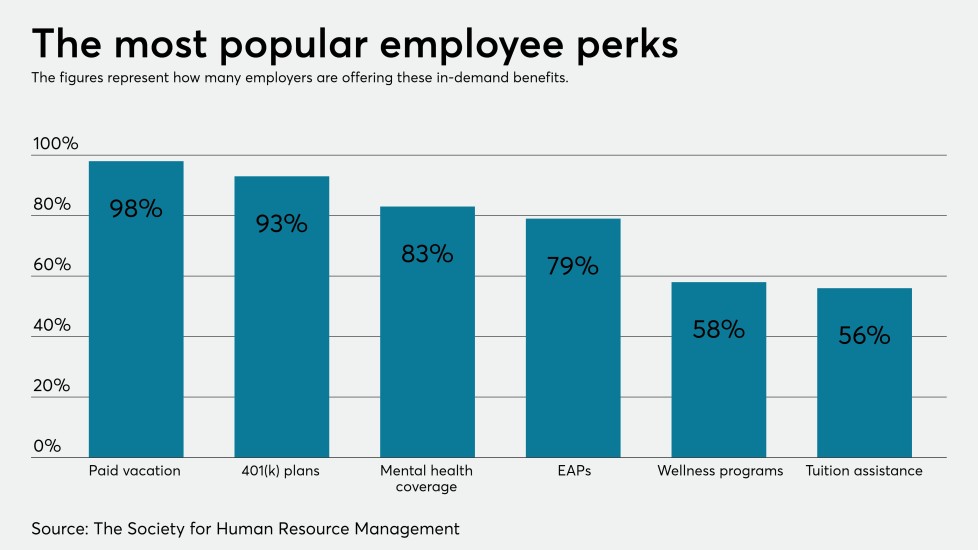Curating the week in wellness April 5th–9th 2021: How to manage the ‘great return,’ the top 16 work perks, and more
The week’s essential content and fresh industry pickings for those dedicated to employee well-being.

Good morning, well-being pros!
We hope you enjoy this week’s enriching content and thought-provoking articles.
As always, please get in touch with any ideas, suggestions or feedback on how we can serve you better. We are grateful for your partnership and for all the excellent work you do.
1. Can companies help employees be happy and healthy?
According to the BBC, the answer is … maybe?
The piece conveys that wellness apps, mindfulness sessions and offering mental health resources are great, but it all comes down to creating a supportive culture. The BBC writes:
“But while those are nice extras, she says that what employees really require are measures that address the root causes of their need for mental health help in the first place. It’s well intentioned, but not good enough, says Harvey, for companies to provide resources that are reactive, designed to help someone already in distress. “If you’re not doing that alongside creating a supportive work environment, then you’re not resolving the problem, you’re just putting a plaster on it,” she says. “The two have to go hand-in-hand.”
“This means instituting proactive policies like flexible hours and schedules as well as investing in relationship building among teams and between managers and employees. These, plus regular assessment of whether there’s balance between job loads and the resources workers have to complete them, all contribute to meaningfully lower levels of stress, anxiety and burnout.”
The piece also links to Accenture research that reveals criteria that fuel a supportive work environment.
2. How to manage the ‘great return.’
As more companies reopen offices, it’s crucial to handle this historic moment with empathy, care and compassion for your workers—many of whom would be delighted to never commute again. However, many are extremely eager to get back to work.
Forbes has a piece that touts the benefits of workplace camaraderie:
“Coming together is a basic tenet of humanity, and work is fundamental to our feeling of connection and contribution. Working together in offices gives us opportunity to the build relationships with those who have also shown up to do good work. It provides a palpable sense of all we’re contributing to the whole—and these senses of both relationship and reward bode well for individuals, teams, organizations and communities.”
Forbes expounds upon the power of proximity, noting that a physical office makes it easier to build and sustain a healthy culture, spark innovation, bolster employee engagement and retention, and facilitate more robust results.
Most folks seem to be pursuing some variation of “hybrid” work moving forward, so you might consider a flexible arrangement that suits your unique workforce.
3. Minding workplace expectations of millennials and Gen Z.
Gallup has published fresh research that reveals what younger workers want—and expect—from their employer. The pieces notes that Gen Z and millennials already comprise about 46% of the full-time U.S. workforce, so these four findings should be a top-level concern:
- Above all, Gen Z and millennials want an employer who cares about their wellbeing.
- Gen Z and millennials want their leaders to be ethical.
- Older millennials want open, transparent leaders.
- Gen Z and younger millennials want leaders who support a diverse and inclusive workplace.
4. How companies can ease the strain on employees’ mental health.
To provide more meaningful support, the L.A. Times writes that “The most important step for employers to take is honestly assessing how they manage and treat their workers.”
The piece also suggests:
- Sending out anonymous engagement surveys.
- Using a third-party company to conduct anonymized focus groups.
- Closely monitoring EAP use.
- Inviting open conversations in forums where employees feel comfortable sharing honest thoughts.
- Making employees keenly aware of what benefits and resources are available to them.
- Reassuring employees it’s safe to accept help.
- Allowing schedule flexibility and understand different work styles.
- Offering financial support if possible.
- Prioritizing sustainability by making sure mental health support is a part of the company’s overall budget moving forward.
The piece also offers these resources:
“Staglin recommends Mental Health First Aid’s training curriculum for people who want to grow as mental health ambassadors in the workplace.
Grabarek points to the Wellness Council of America’s training courses as another resource for businesses.
Those interested in mental health apps can take a look at One Mind’s PsyberGuide, which offers expert reviews of such apps.”
This JD Supra piece is also jam-packed with smart ideas on how companies can support workers’ mental health well beyond the pandemic.
5. Which work perks do employees love most?
Employee Benefits News shares the top 16 perks and benefits workers adore. You’ll find the usual suspects such as paid vacation, 401(k) plans, EAPs and flex spending accounts near the top, but you might be surprised to see pet insurance, student loan assistance, and PTO for volunteering, too.

How do your offerings stack up? It’s a good thing to weigh on National Employee Benefits Day!
6. Easing back into an office environment.
To facilitate a smooth transition back to the ol’ sawmill, Law360 suggests:
- Provide incentives for healthy behavior.
- Enhance your employee assistance program—with a special focus on helping workers secure child care or elder care.
- Offer structured treatment plans to help staffers manager illnesses.
However you go about it, make sure wellness is at the cornerstone of any return-to-work plans.
7. How Whole Foods, Comcast and other big companies are pursuing wellness.
Comparably has published a behind-the-scenes peek at wellness activities for seven companies.
Comcast shares:
“We provide a wide array of benefits that support the physical, emotional, and financial wellbeing of our employees, their families, and their communities. We offer support tools, so our teammates don’t have to be an expert to find the right care for themselves and their families. Employees can talk or message a dedicated health assistant or find answers themselves using self-service tools.”
A Whole Foods wellness rep writes:
“For our Total Health Immersion Program, we send select Team Members to a week-long health getaway to help create and sustain healthy lifestyle changes. We pay 100% of the travel costs and even 50% of their spouse’s costs if they want to join. The program includes a variety of unique, intensive health and wellness program experiences. Our Team Member Assistance Plan (TMAP) is a free and confidential service that provides counseling and support for many of life’s challenges, both personal and interpersonal. Through TMAP, we provide Team Members and their family members 24/7 unlimited access to licensed, master’s level clinicians.”
ClearSale shares:
“We hold weekly “personal growth” seminars for team members. Topics run the gambit from the importance of work/life balance, to how to deal with difficult emotions, to deep dives on products that team members might be interested in learning more about. We invite experts to come and speak in these seminars, and we have found that employees enjoy them quite a bit. Since the pandemic, we have not been able to plan the many in-person cultural events that we used to. However, we have supplemented by offering for team members with interesting hobbies like yoga, Zumba, musical talent, etc. to hold online classes or concerts for their fellow employees. This allows our team members to not only participate in an entertaining wellness program but to also have access to the personal lives of other employees. It’s a great bonding exercise.”
8. Research reveals a bottom-line boost for wellness investment.
A New Zealand study has found a “bottom line boost for businesses that invest in the well-being of their staff.” As Stuff writes:
“The research commissioned by global technology company Xero and carried out by the New Zealand Institute of Economic Research shows that for every dollar invested in organizational well-being initiatives the financial return is an average of five times that and could be as high as 12 times within a year.”
The piece elaborates:
“The research found that the return for investing in wellbeing initiatives was measured through staff productivity improvements. Two key areas for small businesses to invest in were analyzed. One was organizational wellbeing through wellbeing education programs, fostering environments supportive of mental health, and organizing specific activities designed to improve staff wellbeing. The other was employee assistance programs like offering staff professional counselling to help them with their mental wellbeing. That showed a return of between three and five times for every dollar spent.”
9. Want to move the well-being needle? Change the ‘employee experience.’
EBN writes that to do so, you must:
- Be transparent about workplace monitoring and data collection.
- Use data to see who is struggling and why.
- Bring data together across systems and departments to get the whole picture.
- Use insights to take action, and measure the results.
- Set goals and measure progress to ensure your mental wellness efforts are working.
- Ask questions about the value and awareness of programs, and monitor turnover, absence, and engagement.
The piece sums it up:
“No organization has a perfect formula for creating a mental wellness program. We can and should do many things and the pandemic has reinforced that the right thing to do can change quickly. But by leveraging data, you can pinpoint problems and measure wellness efforts over time. With the right approach and digital tools, your organization can understand its workers on a deeper level, strengthen trust and better position itself for recovery.”







